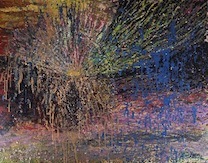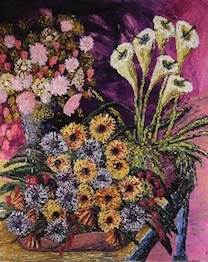AMES, Iowa — When a debilitating stroke robbed him of his ability to speak, Steven Nissen found a new way to express himself through art.
Nissen, formerly a professor of animal science at Iowa State University, will share this journey of self-rediscovery through an exhibition at the ISU College of Design’s Design on Main Gallery, 203 Main St. in downtown Ames.
“Aphasia: Paintings by Dr. Steven Nissen” will feature about 20 acrylic paintings on canvas. The show will open with a reception from 5 to 7 p.m. Friday, Jan. 24. The work also may be viewed by appointment Jan. 25 through Feb. 4 (contact Lyndsay Nissen at 515-231-2907 or lanissen@iastate.edu). Both the reception and exhibition are free and open to the public.
Nissen received a doctor of veterinary medicine (1976) and master’s (1977) and doctoral degrees (1981) in animal science, all from Iowa State. He completed a postdoctoral fellowship in pediatric endocrinology at Mayo Clinic in Rochester, Minn., in 1982, and joined the faculty in the ISU Department of Animal Science. He was well known for his research on various aspects of animal and human growth and metabolism.
In August 2008, a stroke left Nissen paralyzed on the right side and unable to speak, ending his academic career. Following years of intensive physical, occupational and speech therapy, Nissen can walk with a brace and a cane and has learned to use his left hand for daily activities. But he has not regained high-level ability to speak, write or read. He communicates through gestures, facial expressions, a few spoken phrases, typing on an iPad and — since late 2010 — painting.
Nissen took up a brush as a way to express complicated, sometimes unsettling and sometimes simply delightful ideas, said his daughter, Lyndsay, an ISU graduate student in integrated visual arts, who curated the work for this exhibition.
“My father was an incredibly goal-oriented person, and after the stroke, he found himself unable to accomplish the same type of goals,” Lyndsay said. “I believe painting allows him some of that personal satisfaction of creation and completion. It is a solitary activity that doesn’t require the skills he has lost.”
Nearly all of the imagery in her father’s work has three main subjects: still life, nature, and abstract patterns of light with or without figures, Lyndsay said. He uses very bright, neon colors and applies the paint in rough strokes with heavy stippling.
“The most grand images are his large (4-foot-square) still-life paintings with flowers. They have a loosely realistic style paired with unlikely color choices, then careful detailing pulls them together,” Lyndsay said.
“He has gestured to indicate the abstract paintings are like near-death experiences or visions. These paintings are much more difficult to decipher," she said. "Some obviously deal with the depression he has suffered from his incident and some are just light, heavenly.”

